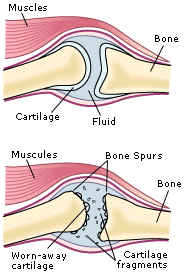From the publishers of The New England Journal of Medicine The StoryNearly three years ago, when a book called "The Arthritis Cure" hit the shelves, people with osteoarthritis began heading to health food stores to buy glucosamine and chondroitin sulfate, the two dietary supplements lauded as part of the so-called cure. Derived from crustacean shells and animal organs, both substances are thought to help restore and maintain cartilage, the tough connective tissue that cushions the ends of the bones. Natural Approach to Treating Osteoarthritis
The Physician's Perspective John Klippel, M.D. Both glucosamine and chondroitin sulfate, which occur naturally in our bodies, have been used to treat osteoarthritis in Europe for more than a decade. The substances have an even longer history for treating stiff, painful joints in dogs and horses in the United States. Extracted from the shells of crab, lobster, and shrimp, glucosamine is a component of proteoglycan, which the body uses to make and repair cartilage. Glucosamine is sold in two different forms (sulfate and hydrochloride) that apparently work equally well. Chondroitin sulfate, a substance made of repeating units of glucosamine with attached sugar molecules, is made from the cartilage-containing windpipe of cattle. Studies suggest that chondroitin draws fluid into tissues, making cartilage more supple and protecting it against destructive enzymes. While animal and test-tube studies have hinted that these two supplements can rebuild cartilage, there's no direct proof that this occurs in people -- or that the supplements can slow or reverse cartilage loss. Nonetheless, the results from this new JAMA study offer fairly solid evidence that the supplements ease pain and help people feel less disabled by their illness. The fact that these supplements appear quite safe is also encouraging. Still, I'd urge anyone to check with their physician -- ideally a rheumatologist who specializes in arthritis -- before taking these supplements. First, it's important to be sure you actually have osteoarthritis and not some other form of arthritis or a different illness, since these supplements have only been used for osteoarthritis. You should also discuss theoretical contraindications with your physician. One such caution is for people who take blood-thinning medications such as heparin or daily aspirin, because chondroitin is structurally similar to heparin. Also, some glucosamine manufacturers warn people with shellfish allergies not to use their product because it is derived from shellfish. Sulfate allergies may also be a concern. In fact, the author of "The Arthritis Cure", Jason Theodosakis, M.D., recommends that people with known sulfate allergies take only glucosamine hydrochloride instead of the sulfate form, and that they avoid chondroitin sulfate altogether. Another possible complication is for people with diabetes, because animal studies suggest that glucosamine can impair the body's response to insulin (the hormone that regulates blood sugar levels). And one small study of people without diabetes found that glucosamine may increase fasting insulin levels. But these findings, presented at a recent scientific meeting, are preliminary and need further study. So far there are no documented reports of human health problems related to any of these concerns. To date, the only known side effects in people are occasional nausea or indigestion. Glucosamine also comes in a cream form, but there's no evidence that topical versions of the supplement help osteoarthritis. The recommended dosage for glucosamine capsules is 1,500 milligrams a day, in two doses; for chondroitin, the amount is 1,200 mg. daily, also in split doses. The supplements aren't cheap, though -- a daily dose costs about a dollar. What's more, you may not even get what you pay for. According to ConsumerLab.com, a company that conducts independent tests of dietary supplements, nearly one-third of 25 major brands of supplements containing glucosamine and/or chondroitin sulfate didn't contain all the labeled ingredients. Of 13 combination supplements, 6 had low chondroitin levels, and the contents of the two chondroitin-only supplements didn't match the label claims. These findings emphasize why we need tighter regulation of dietary supplements. For now, research any supplement you want to take and then discuss it with your doctor. Aside from the potential contraindications, it's important for your doctor to know about any factors that may influence your condition, so you both can discern the probable cause of any changes. (John Klippel, M.D., is medical director for the Arthritis Foundation in Atlanta.) For More Information: The Arthritis Foundation, 800-283-7800 National Institute of Arthritis and Musculoskeletal and Skin Diseases |
